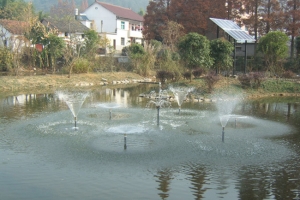污水处理为使污水达到排水某一水体或再次使用的水质要求对其进行净化的过程。水资源的日益短缺和水污染逐渐加剧,污水处理成为目前水资源保护的一种重要方式,污水处理工艺多种多样,怎样成为一个污水处理专家,以下知识不得得看!
1、什么是生物污水处理法?
◆生物处理是利用微生物来吸咐、分解、氧化污水中的有机物,把不稳定的有机物降解为稳定无害的物质,从而使污水得到净化。现代的生物处理法,按作用微生物的不同,可分好氧氧化和厌氧还原两大类。前者广泛用于处理城市污水和有机性工业废水。好氧氧化应用较广包含着很多艺种工艺和构筑物。生物膜法(包含生物过滤池、生物转盘)、生物接触氧化等多种工艺和构筑物。活性污泥法和生物膜法都是人工生物处理方法。此外还有农田和池塘的天然生物处理法,即灌溉田和生物塘。生物处理成本低廉,因此是目前应用广泛的污水处理方法。
2、什么是废水处理量或BOD5去除总量和处理质量?

◆污水处理量或BOD5去除总量:每日进入污水厂处理的总污水流量(以m3/d计),可作为污水厂处理能力的一个指标。每日去除BOD5的总量亦可作为污水厂处理能力的指标。去除BOD5总量等于处理流量与进出水BOD5差值的乘积,以kg/d或t/d为单位。
◆处理质量:二级污水处理厂以出厂的BOD5与SS值作为处理质量指标。按新制订的污水处理厂出水排放标准,二级污水处理厂出水BOD5、SS均小于30mg/L。处理质量也可用去除率来衡量。进水浓度减出水浓度除以进水浓度即为去除率。氨氮、TP出水值或去除率也应用于处理质量指标。
3、什么是pH值及其指示意义?
◆pH表示污水的酸碱程度。它是水中氢离子浓度倒数的对数值,其范围为0~14,pH值等于7,则水呈中性,小于7呈酸性,数值越小,其酸性越强,大于7呈碱性,数值越大,其碱性越强。污水中pH值大小对管道、水泵、闸阀和污水处理构筑物有一定的影响。以生活污水为主的污水处理厂的pH值,通常为7.2~7.8。过高或过低的pH值,均可表明有工业废水的进入。过低的值会腐蚀管道、泵体并可能产生危害。例如污水中的硫化物会在酸性条件下,生成H2S气体。高浓度时使操作工作头痛、流涕、窒息甚至死亡。为此发现pH降低必须加强监测,寻找污染源,采取对策。同时,生化处理的pH允许范围是6~10,过高或过低都可影响或破坏生物处理。
4、什么是总固体(TS)?
◆是指水样在100℃温度下,在水浴锅上蒸发至干所余留的总固体数量。它是污水中溶解性固体和非溶解性固体的总和。它可反映出污水中固体的总浓度。通过进出水固体的分析可反映出污水处理构筑物对去除总固体的效果。
5、什么是悬浮固体(SS)?
◆是指污水中能被滤器截留的固体物质数量。悬浮固体一部分在一定条件下可以沉淀。测定悬浮固体通常是用石棉滤层过滤法进行。主要设备为古氏坩锅。当化验设备条件不具备时,也可采用滤纸作为滤器,从总固体与溶解固体的减差来求得悬浮固体量。测定悬浮固体时,由于滤器不同,常产生较大差异。
◆该项指标是污水比较基本的数据之一。测定进水和出厂水的悬浮固体,可用来反映污水通过初沉池,二沉池处理后,悬浮固体减少的情况,它是反映构筑沉淀效率的主要依据。
6、什么是化学需氧量(COD)?
◆化学需氧量(简称COD)是指用化学方法氧化污水中有机物所需要的氧化剂的氧量。用高锰酸钾作氧化剂,测得的结果习惯上叫做耗氧量,用OC表示。用重铬酸钾作氧化剂,测得的结果称为化学需氧量以COD表示,二者的区别在于选用氧化剂的不同。以高锰酸钾作为氧化剂,只能氧化污水中的直链有机化合物,而以重铬酸钾作为氧化剂,它的作用比前者强烈与完全,除直链有机化合物以外,它能氧化高锰酸钾不能氧化的许多结构复杂的有机化合物。因此,同一污水COD值比OC值大得多。特别是当污水厂有大量工业废水进入时,一般都应测得重络酸钾法的化学需氧量。城市污水厂的COD值一般约为400~800mg/L。
◆高锰酸钾法的耗量值在污水厂中常被用来作为确定五日生化需氧量稀释倍数的参考数据。
7、什么是生化需氧量(BOD)?
◆生化需氧量:(简称BOD)是指在有氧条件下,水中的微生物分解有机物时所需要的氧量。它是一种间接表示有机物污染程度的指标,有机物的生化氧化分解通常有二个阶段,第一阶段主要是含碳有机物的氧化,称为碳化阶段,约需20天才能完成。第二阶段主要是含氮有机物的氧化、称为硝化阶段,约需100天才能完成。在公认的情况下,一般标准做法是在20℃温度下,培养5天,进行测定,测得数据称为五日生化需氧量。简称BOD5,因此BOD5表示部分含碳有机物分解的需氧量,生活污水的BOD5应约在70%左右。
◆五日生化需氧量的测定,是取原水样或经过适当稀释的水样,使其含有足够的溶解氧,以满足五日生化需氧的要求,将此水样分成二份,一份测得当天的溶解氧含量,而将另一份放入20℃培养箱内,培养5天后再测定其溶解含量,两者之差乘上稀释倍数即为BOD5。
◆BOD5测定过程中,正确选择稀释倍数至关重要。通常认为,选择的稀释倍数应使经过稀释的水样在20℃恒温箱内培养5天后,它的溶解氧减少在20%~80%时较为适当。但是,有时常因BOD5的稀释倍数掌握不当造成数值上的误差,甚至稀释倍数太小而得不到BOD5的数据。
8、测定BOD的用途?
◆BOD可反映污水被有机物污染的程度,污水中所含有机物越多,则消耗氧量亦越多,BOD数值也越高,反之亦然。因此它是污水水质指标中比较为重要的一个。尽管测定BOD需时较长、数据不及时,但BOD指标带有综合性——综合反映有机物总量,模拟性——模仿水体自净。因此很难用其他指标来代替。
对于污水处理厂来说,该指标的用途为:
a.反映污水有机物浓度。如进厂污水有机物浓度,出厂污水有机物浓度。城市污水处理厂进水BOD5一般可达150~350mg/L。
b.用以表示污水处理厂的处理效果。进、出水BOD5的减差除以进水BOD5即为该厂的BOD5去除率,是重要的指标。
c.污水处理厂的去除总量与出水BOD5,表示了在污水厂总的处理能力与对水体环境的影响量。
d.用来计算处理构筑物的运转参数,如曝气池的污泥负荷BOD5kg(MISS)或容积负荷BOD5kg/(m3/d)。
e.反映污水处理厂运转的技术经济数据,如除去每kgBOD耗用电量(度),去除每kgBOD5需要的空气量。
f.衡量污水可生化程度,当BOD5/COD大于0.3时,说明污水可以进行生化处理。小于0.3时,则难以生化处理。比值在0.5~0.6时,生化过程很容易进行。
◆由此可见,测定BOD5的用处很大,它是污水处理厂比较重要的一个测定项目。但测定所需时间较长,不能及时出数据。COD的化验反映污水中有机物被氧化剂氧化所需氧量,它的数据值接近于全部有机物的需氧量。因此它也有较大用处,而且COD测定时简短,一般城市污水厂COD﹥BOD,如果污水中有机物种类变化较少,则COD与BOD有一定的相互关系,因此就可用当天的COD来预测BOD5值。
◆根据各城市污水处理厂的运转数据,通常SS与BOD5在数值上大致相仿或者略为高些。如上海各污水厂的SS比BOD5在数值上平均高出50mg/L左右。
◆在进厂污水中如发现BOD5与SS成倍增长,则可能有高浓度的有机废水流入或者粪便大量进厂。这样将会增加处理负荷。使处理效率降低,甚至还会阻塞管道,必须追查原因,采取措施。
9、总氮、氨氮、亚硝酸盐氮、硝酸盐氮 (N、NH4+、NO2-NO-3)指示意义?
◆污水中有大量的含碳有机物与含氮有机物,前者以碳、氢、氧为基本元素。后者以氮、硫、磷为基本元素。含氮有机物在好氧分解过程中,最终会转化为氨氮肥、亚硝酸盐氮肥、硝酸盐氮、水和二氧化碳等无机物。因此测定上述三个指标可反映污水分解过程与经处理后无机化的程度。当二级污水处理厂中只有少量亚硝酸氮出现时,该处理出水尚不能稳定,当氧量不足时,则污水中的有机氮大多数转化为无机物,出水流入水体后是较为稳定的。一般进厂污水的氨氮值约30~70mg/L。进厂水中一般不含有亚硝酸盐与硝酸盐。二级污水处理厂一般不能大量除氮肥,处理程度较高时,能够将部份氨氮转化为硝酸盐氮。
10、磷、氮(P、N)指标意义?
◆污水中磷和钾的含量影响微生物的生长,活性污泥污处理污水要维持BOD5:N:P的比例在100:5:1以上,在城市污水厂,一般都能达到这个比例。有些工业废水达不到这个比例,就必须向污水添加营养剂。
11、什么是溶解氧、测定目的是什么?
◆溶解氧是指溶解于水中的氧量,它与温度、压力、微生物的生化作用有密切关系。在一定温度下,水中最多只能溶解一定量的氧,例如20℃时,蒸馏水的溶解氧饱和值为9.17 mg/L。
◆在污水处理中常常测定出水和曝气池中的溶解值,根据它的大小来调节空气供应量,了解曝气池内的耗氧情况以判断在各种水温条件下,曝气池耗氧速率。在运转过程中,要求曝气池内的溶解氧在1 mg/L以上,过低的溶解氧值表明曝气池内缺氧,过高的溶解氧不但浪费能耗,且可能造成污泥松碎、老化。
◆污水处理厂出水中含有溶解氧对水体环境是有益的,在可能的条件下,应让出水带有些溶解氧。
◆溶解氧在水体自净过程中是个重要参数,它可反映水体中耗氧与溶氧的平衡关系。
12、水温对运行的关系?
◆水温,水温对曝气池工作有着很大的关系。一个污水厂的水温是随季节逐渐缓慢变化的,一天内几乎无甚变化。如果发现一天内变化很大,则要进行检查,查否有工业冷却进入。全年在8~30℃范围内,曝气池在水温8℃以下运行时,处理效率有所下降,BOD5去除率常低于80%。
13、污泥负荷是什么?怎样调节?
a.污泥负荷=进入曝气池的BOD5数量(流量×浓度)/曝气池中MLSS总量(MLSS×池积)。
b.由于初沉池出水中的BOD5数量决定于进厂水质,一般难以调节,调节污泥负荷,减少MLSS,则提高污泥负荷,增加或减少MLSS一般通过增加或减少排泥来实现。
◆污泥负荷对处理效果,污泥增长和需氧量影响很大,必须注意掌握。一般来说,污泥负荷在0.2~0.5kg(BOD5)/(kg.d,掌握在0.3kg(BOD5)/「kg(MLSS).d」左右。
14、曝气池容积负荷?
◆曝气池单位容积每天负担的BOD5量称为容积负荷kg(BOD5)/(m3.d)。容积负荷表示了建造该曝气池的经济性。容积负荷和混合液浓度及污泥负荷有如下关系:
BV=x.B5,式中(x即MLSS)。
15、污泥泥龄含义?
◆污泥泥龄=曝气池内MLSS数量(MLSS×池积)/剩余污泥中固体量(排放量×排泥浓度)。
◆污泥泥龄是曝气池中工作着的活性污泥总量与每天排放的剩余污泥之比值,单位是d。在运行平稳时,可理解为活性污泥在曝气中平均停留时间。
◆一般曝气池系统的污泥泥龄约5~6d。当要达到硝化阶段时,污泥泥龄需达8~12d或更高。
◆污泥泥龄和污泥负荷有相反的关系,污泥泥龄长,负荷低,反之亦然,但并不成绝对的反比例函数关系。
16、混合液悬浮固体浓度(MLSS)?
◆混合液悬浮固体浓度是曝气池中污水和活性污泥混合后的混合液悬浮固体数量,单位(mg/L),它是计量曝气池中活性污泥数量的指标,由于测定简便,往往以它作为粗略计量活性污泥微生物量的指标。在推动流曝气中MLSS一般为1000~4000mg/L,在合建的完全混合曝气池中,空气曝气的MLSS根少有超过8000mg/L。这是因为MLSS过高。妨碍充氧,也使它难以在二沉池中沉降。
17、混合液挥发性悬浮固体浓度(MLVSS)?
◆混合液挥发性悬浮固体浓度是指混合液悬浮固体中有机物的重量(通常用600℃下的烧灼减量来测定),故有人认为能较MLSS更确切地代表活性污泥微生物的数量。不过MLVSS中还包括非活性的不能降解的有机物、也不是计量MLSS的比较理想指标,对于生活污水,常在0.75左右。
18、污泥指数(SVI)?
◆污泥指数指曝气池混合液经30min静沉后,相应的1g干污泥所占的容积(以ml计)即:
SVI=混合液30min静沉后污泥沉积(ml)/污泥干重(g)
SVI值能较好地反映出活性污泥的松散程度和凝聚沉降性能。良好的活性污泥SVI常在50~300之间,SVI过高的污泥浓度,在相同浓度情况下测得的SVI值才有价值。另因测定容器的大小对测定的数量有一定的影响,必须统一测定容器。
1. What is biological sewage treatment method?
◆ biological treatment is to use microorganisms to absorb, decompose and oxidize the organics in the sewage, degrade the unstable organics into stable and harmless substances, so as to purify the sewage. Modern biological treatment methods can be divided into aerobic oxidation and anaerobic reduction according to different microorganisms. The former is widely used to treat municipal wastewater and organic industrial wastewater. Aerobic oxidation is widely used in many processes and structures. Biofilm process (including biological filter, biological turntable), biological contact oxidation and other processes and structures. Activated sludge process and biofilm process are both artificial biological treatment methods. In addition, there are natural biological treatment methods for farmland and pond, i.e. irrigation field and biological pond. Biological treatment is the most widely used sewage treatment method because of its low cost.
2. What is the total amount of wastewater treatment or BOD5 removal and treatment quality?
◆ sewage treatment capacity or total BOD5 removal capacity: the total sewage flow into the sewage treatment plant for treatment every day (in m3 / D), which can be used as an indicator of the treatment capacity of the sewage treatment plant. The total amount of BOD5 removed per day can also be used as an indicator of sewage treatment capacity. The total amount of BOD5 removed is equal to the product of the treatment flow and the difference of BOD5 in and out water, in kg / D or T / d.
◆ treatment quality: the treatment quality index of the secondary sewage treatment plant is the factory BOD5 and SS value. According to the new effluent discharge standard of WWTP, the effluent BOD5 and SS of WWTP II are less than 30mg / L. The treatment quality can also be measured by the removal rate. The removal rate is the concentration of influent water minus the concentration of effluent water divided by the concentration of influent water. Ammonia nitrogen, TP effluent value or removal rate are also used for treatment quality index.
3. What is pH value and its indicating significance?
◆ pH indicates the acid-base degree of sewage. It is the reciprocal value of the concentration of hydrogen ions in water. Its range is 0-14, pH value is equal to 7, then the water is neutral and less than 7 is acidic. The smaller the value is, the stronger its acidity is, and more than 7 is alkaline. The larger the value is, the stronger its alkalinity is. The pH value in the sewage has certain influence on the pipeline, water pump, gate valve and sewage treatment structure. The pH value of the sewage treatment plant mainly containing domestic sewage is usually 7.2-7.8. If the pH value is too high or too low, it can indicate that there is industrial wastewater. Too low a value will corrode the pipeline, pump body and may cause harm. For example, sulfide in sewage will generate H2S gas under acidic conditions. When the concentration is high, it will cause headache, runny nose, suffocation and even death. Therefore, it is necessary to strengthen monitoring, find out pollution sources and take countermeasures. At the same time, the allowable pH range of biochemical treatment is 6-10, too high or too low can affect or destroy biological treatment.
4. What is total solid (TS)?
◆ it refers to the total amount of solid left after the water sample evaporates to dryness on the water bath at 100 ℃. It is the sum of dissolved and non dissolved solids in sewage. It can reflect the total concentration of solid in sewage. Through the analysis of the solid in and out of the water, the effect of the sewage treatment structure on the removal of the total solid can be reflected.
5. What is ss?
◆ refers to the quantity of solid substances in the sewage that can be intercepted by the filter. Part of the suspended solids can precipitate under certain conditions. The determination of suspended solids is usually carried out by asbestos filter. The main equipment is ancient crucible. When the conditions of the test equipment are not available, filter paper can also be used as a filter to obtain the amount of suspended solids from the difference between total solids and dissolved solids. In the determination of suspended solids, there are great differences due to different filters.
◆ this index is one of the most basic data of sewage. The determination of the suspended solids in the incoming and outgoing water can be used to reflect the reduction of the suspended solids after the sewage passes through the primary sedimentation tank and the secondary sedimentation tank, which is the main basis for reflecting the sedimentation efficiency of the construction.
6. What is chemical oxygen demand (COD)?
◆ chemical oxygen demand (referred to as COD) refers to the oxygen content of the oxidant needed to oxidize the organic matter in sewage by chemical methods. When potassium permanganate is used as oxidant, the measured result is customarily called oxygen consumption, which is expressed by OC. When potassium dichromate is used as oxidant, the measured result is called cod. The difference between the two lies in the choice of oxidant. With potassium permanganate as oxidant, it can only oxidize straight chain organic compounds in sewage, while with potassium dichromate as oxidant, its action is stronger and more complete than the former. Besides straight chain organic compounds, it can oxidize many complex organic compounds that potassium permanganate cannot oxidize. Therefore, COD value of the same sewage is much higher than OC value. Especially when a large amount of industrial waste water enters the sewage plant, the chemical oxygen demand of the method of potassium bichromate should be measured generally. The COD value of municipal wastewater treatment plant is generally about 400-800mg / L.
◆ the consumption value of potassium permanganate method is often used as the reference data to determine the dilution ratio of five-day biochemical oxygen demand in sewage plants.
7. What is biochemical oxygen demand (BOD)?
◆ biochemical oxygen demand (BOD for short) refers to the oxygen required by microorganisms in water to decompose organic matters under aerobic conditions. It is an indirect indicator to indicate the pollution degree of organic matter, and the biochemical oxidation and decomposition of organic matter

电话:0571-81671995
传真:0571-81671995
地址:杭州市古墩路1359号旺君国际A座18层